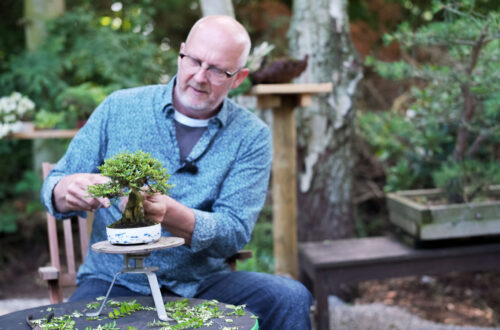Bonsai works in India
At my recent travel to India I did a lot of work during my stay. One of the tasks was to refine or totally restyle some already established bonsai. Also a few Shohin was made from raw material. Here I will show some of the trees I have done, with the kind assisting by my friends in India.
First tree is a local variety Juniper, closely related to the common Chinese juniper seen in Europe. This specie has lighter and a little longer growth. It is a clump/forest style tree, that needed to be initially styled.


Juniper after styling. This is initial styling work. Therefore strong growth are left after cutting the tips back to semi-hard wood. Branches are positioned, and next step is to refine and change smaller branches when new grow is established. The tree is opened up at this stage, so new growth can develop when light reaches the inner branches. The strongest growth must be controlled and trimmed regularly to even the balance of growth.
Next tree to show is also a medium size bonsai pre-trained as a bonsai forest.





The tree was moved to the left side of the new pot, because the movement of the tree is to the right. As it is clearly seen, that means that some roots have to be reduced in size to fit the pot.


A larger pot is selected as temporary second pot.

Because it is not safe to remove a large portion of the roots at the same time, the tree is double potted. This means that we put the replaced tree in another larger pot, to give it time to renew the roots after transplanting. Then the redundant roots can be cut back in steps, without disturbing the rest of the root mass. A safe and healthy method to remove roots and add vigour to other parts at the same time. Later when the roots are safely removed at the left side (seen from the front), the large pot is removed.


Another Juniper needed a fine tune. After removing overgrown branches the tree was wired, and repotted by gently moving it to a better pot without cutting any roots. A refinement of the deadwood was part of the restyling, enhancing the beauty and age of this medium size bonsai.


Branches are refined and now need to grow and be trimmed to balance growth, and develop foliage pads. In the tropical climate this expected to happen in a short time. The deadwood was carved with powertools.


Shimpaku juniper removed temporarily from its pot to be able to work on it. The tree was changed to a cascade style bonsai which needed some drastice pruning and changing the growth direction of the tree.


The lower part of the tree has been pruned and wired. The tree is also tilted to make the cascade style.


Positioned in a temporary pot after initial styling. Now new growth has to improve the tree with time.
And another one. Also a tree going in the cascade fashion. Because it simply invited to. This also is initial first work on a future bonsai. Dont mistake this work as finished trees, because there is no such thing when we work on trees that are drastically styled and changed. It will always be the first step in a series before we reach a mature and well developed bonsai over time.
The first work sets the direction, and the future work refines and improves.


Finishing with a few other trees among the bonsai I worked on during my stay.


Another cascade initial work that needs development.




No Comments
africanbirding
Reblogged this on Wolf's Birding and Bonsai Blog.